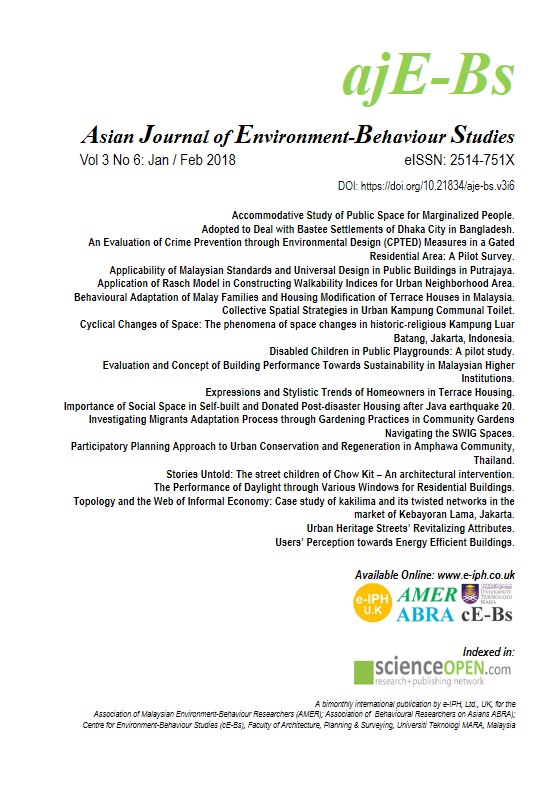Accommodative Study of Public Space for Marginalized People
Main Article Content
Abstract
A good public space must be accommodative for everyone included the marginal, the forgotten, the silent (Badshah, 1996), and an undesirable people. “Cities for the Citizen ‘(Douglas & Friedmann, 1998) serves a slogan. Accommodative public space for marginal people and marginal activities can be created when physical aspects of space can accommodate the space needs of the Forgotten (Badshah, 1996). Thus, the society will be educated to learn and share, to respect the rights of other users in the city, and consequently the physical quality of the visual city will be better because there are no annexation of space and overlapping activities.
Article Details
License
Copyright (c) 2018 Wakhidah Kurniawati

This work is licensed under a Creative Commons Attribution-NonCommercial-NoDerivatives 4.0 International License.
References
Badshah, Akhtar A. (1996). Our Urban Future, New Paradigms for Equity and Sustainability. London & New Jersey: Zed Books Ltd
Carr, Stephen et al. (1992). Public Space. New York : Van Nostrand Reinhold Company.
Cooper and Francis. (1997). People Places. New York : Van Nostrand Reinhold Company.
Dictionary.com, Random House. 2011 http://www.answers.com/topic/ marginal-people#ixzz1HDDMOJms www.cpted.com.au. http://www.pps.org/articles/grplacefeat/www.romanforum.org http://www.wikipedia.org.
Douglass, Mike and Friedmann, John. (1998). Cities For Citizen. Planning and The Rise of Civil Society in A Global Age. England: John Wiley and Sons.
Firdaus, Ginanjar. (2007). Peluang Pengembangan Public Skatepark di Ruang Terbuka Publik Pusat Kota Semarang. Tugas Akhir tidak diterbitkan, Perencanaan Wilayah dan Kota, Fakultas Teknik Universitas Diponegoro, Semarang.
Gallion, Arthur B and Eisner, Simon. (1986). The Urban Pattern: City Planning and Design. Van Nostrand Reinhold Company.
Hall, Peter and Pfeifer, Ulrich. (2000). Urban Future 21, A Global Agenda for Twenty-First Century Cities. The Federal Ministry of Transport, Building and Housing of the Republic of Germany. NY: E & FN Spon.
Harvey, David. (1973). Social Justice and the City. London: Erdward Arnold. Madanipour, Ali. (1996). Design of Urban Space; an Inquiry into a Socio-spatial Process. Chichester, England: John Wiley & Sons.
Moudon, Anne Vernez. (1987). Public Street for Public Use. New York: Columbia University Press.
Newman, Oscar.(1972). Defensible Space. New York: Macmillan.
Newman, Oscar. (1996). Creating Defensible Space. U.S.: Department of Housing and Urban Development Office of Policy Development and Research.
Oxford Learner’s Pocket Dictionary.1983.
Robinson, Matthew.(1996). The Theoretical Development Of ‘CPTED’: 25 Years Of Responses To C. Ray Jeffery .
Setiawan, Bobi. (2004). ”Ruang Publik Dan Modal Sosial : Privatisasi Ruang Di Kampung.” InfoURDI, Vol. 17, April-Juni.
Syamsura, Ary. (2004). Ruang Publik Bagi Publik dalam InfoURDI Vol. 17, April-Juni 2004.
Yatmo, Yandi Andri. (2008). Street Vendors as ‘Out of Place’ Urban Elements. Journal of Urban Design, Vol. 13. No. 3, 387–402, October 2008. Routledge, Taylor and Francis Ltd.

